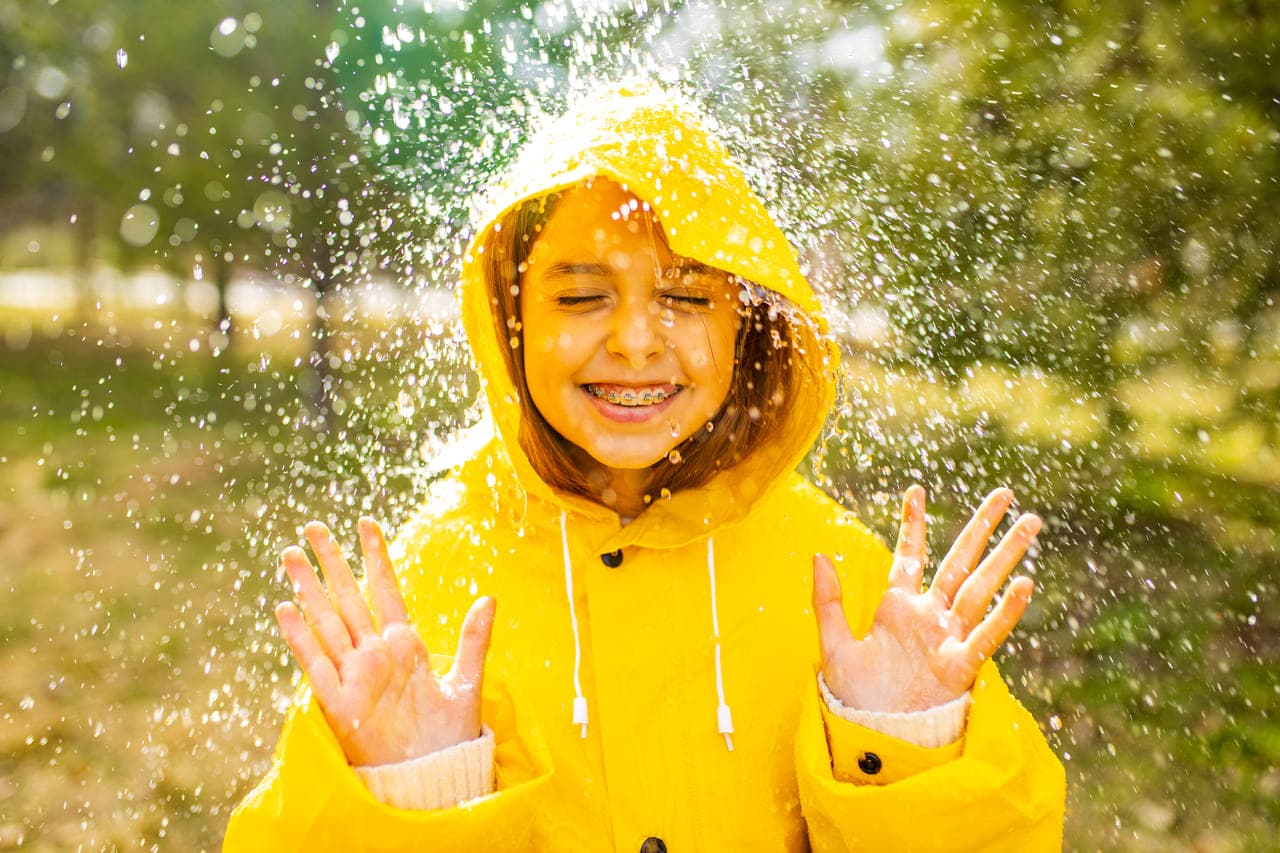As a parent, ensuring your little one’s comfort and protection in all weather conditions is a top priority. When the skies open up and the rain starts to pour, you want to be confident that your baby stays dry, warm, and happy. This is where a quality baby rain jacket comes into play. A well-chosen rain jacket can make a world of difference, transforming gloomy, wet days into opportunities for fun-filled puddle-splashing adventures.
But how do you choose the perfect rain jacket for your little one? What factors should you consider, and what features should you look out for? In this comprehensive guide, we delve into everything you need to know about baby rain jackets. We’ll discuss their importance, what to consider when buying one, and some top picks that offer the best combination of protection, comfort, and style. Whether you’re planning a rainy day outing or preparing for the unpredictable weather, this guide will equip you with all the knowledge you need to make an informed choice.
In This Article
Why Invest in a Baby Rain Jacket?
A baby rain jacket is more than just a cute addition to your little one’s wardrobe. It’s a functional piece of clothing designed with the primary goal of providing protection against harsh weather conditions, particularly rain. Here are some key benefits:
Protection Against Weather Elements The most obvious benefit is that a rain jacket keeps your baby dry when it’s raining. It’s typically made of waterproof or water-resistant materials that prevent rain from seeping through and getting your baby wet. This is especially important because staying wet for extended periods can cause discomfort, and in colder temperatures, can lead to hypothermia.
Keeps Baby Comfortable Rain jackets designed for babies often incorporate soft, breathable linings to ensure comfort. These linings provide a cozy layer of warmth, while the outer layer shields from rain, wind, and even snow in some cases. Many rain jackets also come with hoods for added protection, ensuring your baby’s head and neck area stay dry.
Allows Outdoor Play With a good rain jacket, wet weather doesn’t have to mean being cooped up indoors. Babies and toddlers can still enjoy outdoor playtimes, allowing them to explore, learn, and have fun, despite the weather conditions.
Easy to Clean Baby rain jackets are typically easy to clean. Many are machine-washable and dry quickly, making them ready for use again in no time.
Factors to Consider When Buying a Baby Rain Jacket
Different Materials Used in Baby Rain Jackets
When it comes to baby rain jackets, the material used greatly determines its effectiveness, comfort, and durability. Here are some common materials used and their pros and cons:
1. Polyvinyl Chloride (PVC)
Pros: PVC is a popular choice for rain gear due to its excellent waterproofing properties. It’s flexible, lightweight, and provides effective protection against rain.
Cons: However, PVC has been associated with various environmental and health concerns. It contains phthalates, which are considered harmful, especially for children. Moreover, PVC is not breathable, which can lead to overheating and discomfort during active play.
2. Nylon (with Durable Water Repellent – DWR coating)
Pros: Nylon is another commonly used material. When treated with a DWR coating, it becomes water-resistant and can effectively repel light to moderate rain while remaining breathable.
Cons: Over time, the DWR coating can wear off, reducing the jacket’s water repellency. It also doesn’t offer the same level of waterproofing as PVC or PU in heavy rain.
3. Polyester (with Polyurethane – PU coating)
Pros: Polyester with a PU coating is a great compromise between PVC and nylon. It offers good waterproofing capabilities (comparable to PVC) and breathability (similar to nylon). It’s also lighter and more flexible than PVC.
Cons: While more eco-friendly than PVC, polyurethane still has environmental impacts. The coating may also degrade over time, requiring reapplication.
4. Gore-Tex
Pros: Gore-Tex is a premium material used in high-end rain jackets. It offers excellent waterproofing and breathability, ensuring maximum comfort.
Cons: The downside is that Gore-Tex baby rain jackets can be quite expensive. They also require special care when washing to maintain their waterproofing properties.
Each material has its advantages and disadvantages. When choosing a baby rain jacket, consider the climate where you live, your baby’s activity level, and your personal preferences regarding sustainability and breath-ability.
Choosing the Right Size and Fit for a Baby Rain Jacket
Selecting the right size and fit is crucial when purchasing a rain jacket for your baby. Here are some tips to guide you:
1. Consider Room for Growth: Babies grow quickly, so it’s wise to choose a rain jacket that offers some room for growth. However, ensure it’s not too large that it hampers their movement or compromises their safety.
2. Layering Space: Depending on your climate, you might need to layer clothing under the rain jacket during colder months. Ensure the jacket has enough room to accommodate additional clothing without being overly tight or restricting movement.
3. Check the Sizing Chart: Always refer to the brand’s specific sizing chart since sizes can vary between brands. If possible, measure your baby’s height, weight, and arm length for a more accurate fit.
4. Comfortable Closures: Choose jackets with easy-to-use closures, like zippers or snaps that won’t pinch or irritate your baby’s skin. Adjustable cuffs and hems are also beneficial for creating a custom fit.
5. Try It On: If buying in-store, it’s always best to try the jacket on your baby before purchasing. If buying online, ensure the store has a good return policy in case the size or fit isn’t right.
Remember, the right size and fit will not only ensure your baby’s comfort but also their safety and the overall effectiveness of the jacket.
Safety Features in Baby Rain Jackets
When purchasing a baby rain jacket, safety should be a top priority. Here are some safety features to look out for:
1. Reflectors: Reflectors are a crucial safety feature to look for, especially if you’ll be outside during dusk or dawn when visibility might be low. They reflect light from oncoming vehicles or streetlights, making your baby more visible and thus safer.
2. Hood: A well-designed hood can protect your baby’s head and face from the rain, wind, and cold. Look for hoods that are adjustable and have a small peak to keep rain out of your baby’s eyes.
3. Safe Closures: Opt for jackets with safe closures, like zippers or snaps, which won’t pose a choking hazard if they come loose. Avoid drawstrings around the neck area as they can pose a strangulation risk.
4. Non-Toxic Materials: Ensure the jacket is made from non-toxic materials. Some rain jackets can contain harmful substances like PVC and phthalates. Opt for jackets that are free from these substances and are labeled as such.
Remember, a good rain jacket is not just about keeping your baby dry; it’s also about keeping them safe. Always consider these safety features when choosing the best rain jacket for your child.
Style and Color for Baby Rain Jackets
When it comes to style and color, the options for baby rain jackets are abundant. Here are some tips to consider:
1. Classic Styles: Classic styles like trench coats, ponchos, or parkas are always a good choice as they never go out of fashion. These styles often come with practical features like hoods and pockets too.
2. Fun Themes: For babies and toddlers, rain jackets with fun themes or featuring their favorite cartoon characters can make wearing a rain jacket exciting. Animal-themed jackets, for instance, with ears on the hood or fun prints, can be very popular.
3. Colors and Patterns: Bright colors not only look cheerful but also increase visibility, which adds an element of safety. Don’t feel restricted by traditional ‘blue for boys’ and ‘pink for girls’ norms. Feel free to choose any color that you or your child likes. Vibrant greens, yellows, reds, and purples are unisex and stand out on gloomy rainy days.
4. Baby Boy and Baby Girl Styles: While many styles and colors are unisex, if you’re looking for something more gender-specific, there are plenty of options. For baby girls, rain jackets in shades of pink or purple with floral prints or ruffles are popular. For baby boys, you might opt for jackets in shades of blue or green with themes like cars, dinosaurs, or superheroes.
Remember, the most important thing is that the jacket serves its purpose in protecting your baby from the rain and keeping them comfortable. The style and color should be secondary considerations – choose something that you and your baby will love!
Cost and Quality of Baby Rain Jackets
When purchasing a baby rain jacket, it’s essential to find a balance between cost and quality. Here are some points to consider:
1. Quality Over Price: While sticking to a budget is important, don’t compromise on quality for the sake of saving a few dollars. A high-quality jacket will offer better protection, last longer, and could potentially be passed down to younger siblings or friends, offering better value over time.
2. Material and Construction: The material and construction greatly influence both the price and quality of the jacket. As mentioned earlier, materials like Gore-Tex are more expensive but offer superior waterproofing and breathability. Check the seams and closures – they should be well-constructed and durable.
3. Brand Reputation: Often, you’re not just paying for the jacket itself, but also the brand’s reputation. Established brands may charge more, but they typically offer reliable quality, good customer service, and better resale value.
4. Extra Features: Features like reflectors, adjustable cuffs, hoods, and lined interiors can add to both the cost and the functionality of the jacket. Decide which features are essential for your needs and whether they’re worth the added cost.
Remember, a good rain jacket is an investment in your baby’s comfort and protection. It’s worth spending a bit more on a jacket that will effectively keep your little one dry and comfortable in wet weather. Your baby’s safety and comfort should always be the top priority.
Care and Maintenance of Baby Rain Jackets
Proper care and maintenance of your baby’s rain jacket will not only ensure it remains effective at keeping your little one dry but also extend its lifespan. Here are some tips on how to properly clean and store these jackets:
1. Follow Manufacturer’s Instructions: Always follow the care instructions provided by the manufacturer. These guidelines are specifically designed for the material and construction of the jacket.
2. Cleaning: Most baby rain jackets can be machine washed in cold water on a gentle cycle with a mild detergent. However, some may require hand-washing or spot-cleaning, especially if they have a waterproof coating that could be damaged by machine washing.
3. Drying: Avoid using a dryer as high heat can damage the waterproof coating on some jackets. Instead, hang the jacket to air dry. Make sure it’s fully dry before storing to prevent mold and mildew.
4. Avoid Bleach and Fabric Softeners: These products can degrade the waterproof coating and should be avoided. Stick to mild, non-biological detergents.
5. Storing: Store the jacket in a cool, dry place away from direct sunlight, which can fade the color and degrade the material over time. Make sure the jacket is fully dry before storing.
6. Regular Checks: Check the jacket regularly for any signs of wear and tear, especially at the seams and closures. Early detection of any damage can prevent further deterioration and maintain the jacket’s effectiveness.
By following these care and maintenance tips, you can ensure your baby’s rain jacket continues to provide reliable protection against the elements, while also getting the most value out of your purchase.
Conclusion
Investing in a quality baby rain jacket is not just about keeping your little one dry during rainy days. It’s also about ensuring their comfort, safety, and overall well-being. A good rain jacket protects your baby from the elements, allows them to enjoy outdoor play regardless of the weather, and gives you peace of mind knowing they are well-protected.
When choosing a rain jacket for your baby, consider factors such as the material, size and fit, safety features, style and color, as well as cost and quality. Each of these factors plays a crucial role in determining the effectiveness, durability, and overall value of the jacket.
Also, remember that proper care and maintenance can greatly extend the lifespan of the jacket, providing better value for your investment over time.
So, whether you’re planning a family trip to a rainy location, preparing for the wet season, or simply want to ensure your baby can enjoy outdoor play no matter the weather, a good quality rain jacket is a worthwhile investment.
Keep these tips in mind as you shop around, and you’ll be well on your way to finding the perfect rain jacket that meets your baby’s needs and ensures their comfort and safety in all weather conditions.










![Home Renovation Guide [2025]](/app/uploads/2021/04/design-hacks-1-378x300.jpg)
